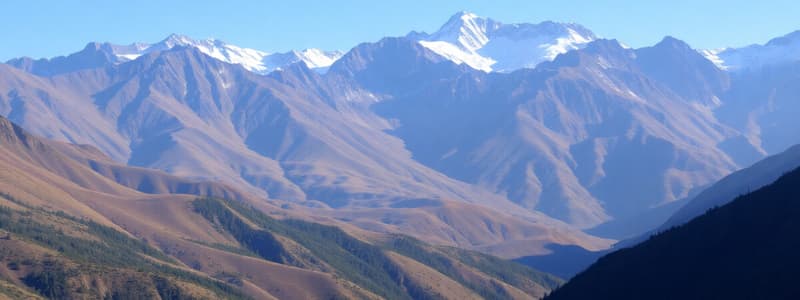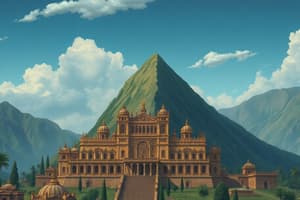Podcast
Questions and Answers
What is a primary economic activity common to the Guianas?
What is a primary economic activity common to the Guianas?
- Tourism
- Textile manufacturing
- Fishing (correct)
- Technology development
Which of the following crops is commonly grown at high altitudes in the Andes?
Which of the following crops is commonly grown at high altitudes in the Andes?
- Cotton
- Wheat (correct)
- Sugarcane
- Rice
Which factor limits large-scale farming in the Andes?
Which factor limits large-scale farming in the Andes?
- Mountainous terrain (correct)
- Utilization of modern technology
- Excessive rainfall
- High population density
What significant cultural figure emerged on the Pampas, symbolizing independent life?
What significant cultural figure emerged on the Pampas, symbolizing independent life?
What environmental concern is associated with the building of hydroelectric dams?
What environmental concern is associated with the building of hydroelectric dams?
What type of farming is practiced by a poorer population in the Andes?
What type of farming is practiced by a poorer population in the Andes?
Which natural resource was extensively mined by the Spanish in the Andes?
Which natural resource was extensively mined by the Spanish in the Andes?
What two groups have heavily influenced the culture of the region?
What two groups have heavily influenced the culture of the region?
Flashcards
What are the three main geographic regions of South America?
What are the three main geographic regions of South America?
The three main geographic regions of South America: the Northern Tropics, the Andean countries, and the Southern Grassland countries.
What are the three Guianas and what do they have in common?
What are the three Guianas and what do they have in common?
Suriname, French Guiana, and Guyana are located in South America and share similar economic activities due to their common natural resources.
What is a mulatto?
What is a mulatto?
A person of mixed African and other ancestry.
What is special about the Andes Mountains?
What is special about the Andes Mountains?
Signup and view all the flashcards
What are the Pampas?
What are the Pampas?
Signup and view all the flashcards
How are the Andes used for agriculture?
How are the Andes used for agriculture?
Signup and view all the flashcards
How are the Pampas used for agriculture?
How are the Pampas used for agriculture?
Signup and view all the flashcards
What are the pros and cons of hydroelectric dams?
What are the pros and cons of hydroelectric dams?
Signup and view all the flashcards
Study Notes
Geographic Context
- South America is divided into three regions: northern tropics, Andean countries, and southern grasslands.
- The Guianas (Suriname, French Guiana, and Guyana) share similar economic activities (fishing, mining, farming) due to shared resources.
- People of mixed African and other ancestry are called Mullattoes.
- The Andes are the world's longest mountain range.
- The Pampas are vast fertile plains used for ranching and commercial farming.
Land Use and Resources
- The Andes have limited good farmland, with much of the eastern area covered by tropical rainforests.
- Farming in the Andes primarily takes place on high plateaus and in narrow mountain valleys.
- Various crops (wheat, coffee, corn, potatoes, fruits, and vegetables) can be grown in different altitudes.
- Commercial farming in the Andes is mostly concentrated in western foothills and coastal areas of Ecuador and Peru.
- Subsistence farming is practiced at higher altitudes.
- Cattle ranching thrives in the Pampas grasslands.
- The Andes have rich mineral resources (gold, silver, copper) mined in the highlands of Peru and Bolivia.
Humans' Interaction with the Environment
- Humans in South America engage in commercial farming, subsistence farming, mining, and cattle ranching.
- Hydroelectric dams are used to generate electricity.
- Dams can cause environmental damage to delicate ecosystems.
Rich Culture
- South American culture is a blend of European and Native American influences.
- The Gaucho, a symbol of independent life, is associated with the Pampas.
- Spanish culture, language, and Catholicism have significant influence.
- Indigenous music incorporates both Spanish and native elements.
- Mestizos (mixed heritage) and indigenous populations play a large role in shaping the culture.
- Indigenous textiles, music, and languages have survived over the centuries.
- Traditional practices like llama and alpaca raising still exist in several South American countries.
Studying That Suits You
Use AI to generate personalized quizzes and flashcards to suit your learning preferences.




